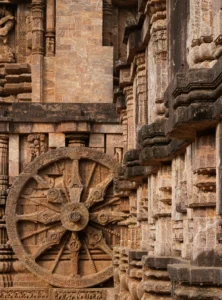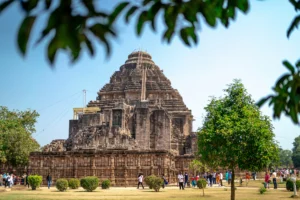Konark Sun Temple is a magnificent temple located in the Indian eastern state of Odisha, near the Bay of Bengal. Carved from stone this marvelous beauty was constructed in the 13th-century. This monument is frozen in time, the sun god Lord Surya was worshipped.
If you really want to appreciate its majestic beauty, one must go beyond its architectural marvel and delve into the legends and symbolism.

Table of Contents
ToggleA Temple Built for the Sun: Lord Surya
The Sun holds a lot of significance in Indian culture and Hinduism. Sun God is known as Lord Surya in Hinduism, he is both a giver of life and a destroyer of darkness. Through centuries, people have offered their first prayers to the rising sun, by offering it water early in the morning after bathing as a sign of acknowledging its power over seasons and human health.
Sun god worship was scientific. In Vedic rituals, sunlight symbolized vision, and truth. Temples dedicated to Lord Surya were often built in a way that honored the path of the sun across the sky. Konark sun temple takes this alignment to another level which literally translates to “Kona” (corner or angle) and “Arka” (sun).
The Tale of Samba
Among the many Konark sun temple legends, one tale echoes more frequently than others. It is the story of Samba, the son of Lord Krishna.
He sought a cure far and wide. Then he was advised to worship Surya, the sun god, whose radiance could cleanse the darkest ailments. For twelve long years, Samba meditated on the sun’s power, offering prayers on the banks of the Chandrabhaga River.
Pleased with his devotion, Surya cured him. Out of gratitude, Samba commissioned a grand temple in honor of the deity who gave him a second life. Thus, Konark was born not from politics or pride, but from penance and faith.
This legend doesn’t just explain the temple’s origin but it reflects the central philosophy of sun god worship. The sun is a healer, a witness, and a deity who rewards discipline and devotion.

The Tale of a Boy and a Sacrifice
Another tale woven into Konark sun temple mythology is that of the temple’s miraculous completion. Under King Narasimhadeva I’s orders, thousands of artisans and architects toiled to construct this massive structure. But the crowning jewel—the installation of the magnetic lodestone at the temple’s peak—remained unsolved.
It’s said that this lodestone was to suspend the main idol mid-air using magnetic repulsion, a feat of engineering so advanced it still sparks debate.
As the deadline neared and the solution remained elusive, panic spread. Failure meant disgrace or worse, death. Then came a 12-year-old boy, Dharmapada, son of a craftsman who worked on the temple. Despite his age, he had absorbed the knowledge passed down from generations. He proposed a solution for placing the final stone, and it worked.
However, Dharmapada feared that the king would punish the workers for accepting help from a child, violating royal protocols. To save them from wrath, the boy climbed to the top and jumped into the sea.
His sacrifice became one with the temple’s legacy, a tale of silent genius and devotion, immortalized in whispers across Odisha. It’s one of the most poignant Konark temple legends, teaching us that greatness is not always born of power which often comes from humility.
Symbolism in Stone: What the Carvings Say
More than just a structure, Konark is a book written in stone. Its walls are etched with over 1,200 carvings of scenes of dance, battle, courtship, meditation, and celestial beings. But beneath the artistry lies deep symbolic meaning.
The temple is built in the shape of a chariot with twelve pairs of wheels and seven horses. The wheels are basically sundials, which accurately tells the time based on shadows. Each spoke is decorated with scenes from everyday life, reminding visitors that time waits for no one.
The seven horses represent the seven days of the week, while the twelve pairs of wheels align with the twelve months of the year. Together, they embody the passage of time driven eternally forward by the sun’s journey across the sky.
Thus, the entire structure becomes a metaphor. It says: life moves, time flows, and the sun watches over all.

Konark and Cosmic Alignment
If you dig deeper into Konark mythology, you’ll find hints of cosmic geometry and solar science. The temple’s orientation is no accident. At the equinox, the sun’s rays would travel through the main entrance, striking the central idol—a marvel of ancient astronomical understanding.
Many scholars believe the temple functioned as a solar observatory. The precision of its angles, the alignment with cardinal directions, and its ability to mark time show that the builders weren’t just artists—they were astronomers, architects, and philosophers.
The Konark Sun Temple that Once Played Music
Here’s a lesser-known layer of the Konark mystery. It is said that the temple once resonated with music. The walls were constructed in such a way that when wind passed through the stone carvings and passageways, it created a symphony of natural sound.
Some believe it was designed deliberately to harmonize with the sound of the ocean and the temple bells. Though time and weather have silenced these melodies, one can almost hear them if you close your eyes and stand still.

Final Thoughts: More Than Just Stone
Konark is not just about history—it’s about belief, devotion, and cosmic curiosity. Every stone has meaning. Every angle, a purpose. And every story, a window into the psyche of a civilization that looked to the sky and dared to reflect its brilliance in stone.
The Konark temple legends aren’t mere folktales—they are truths wrapped in metaphor, carried forward through generations. They remind us why sun god worship was so central to ancient life, not just as ritual, but as reference to something bigger, something that gives and sustains.
In the end, Konark mythology leaves us with a feeling—that human hands, guided by divine inspiration, can create wonders that outlast time.


